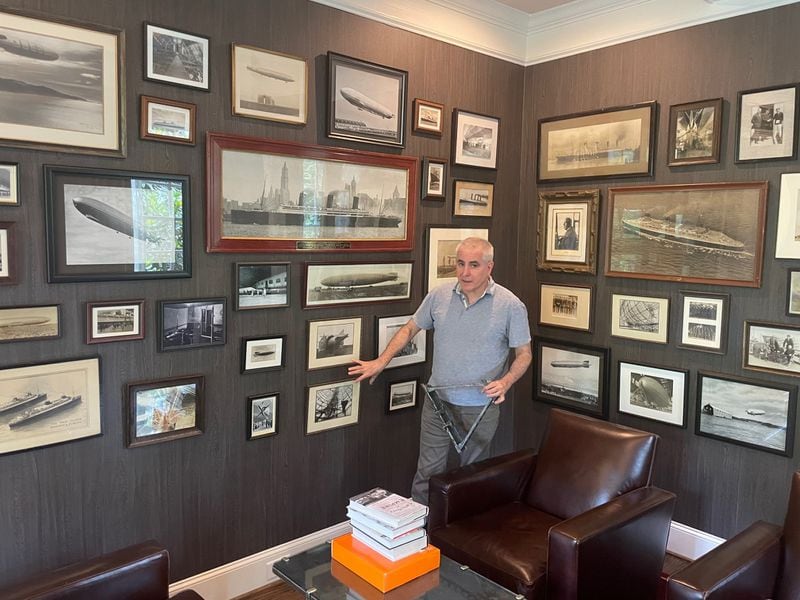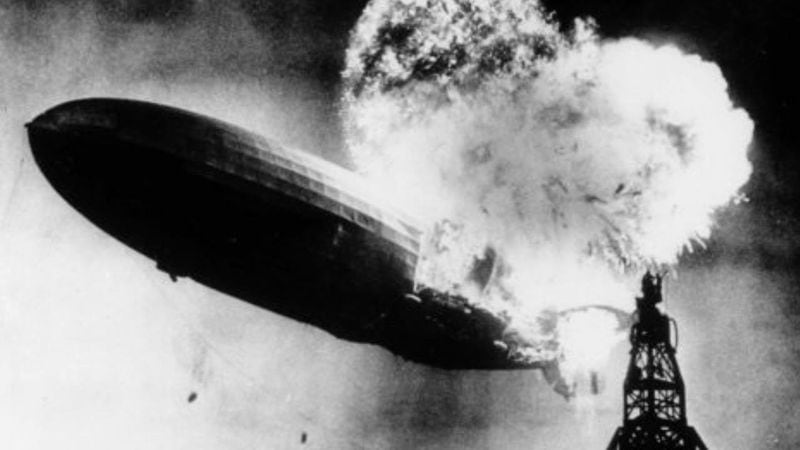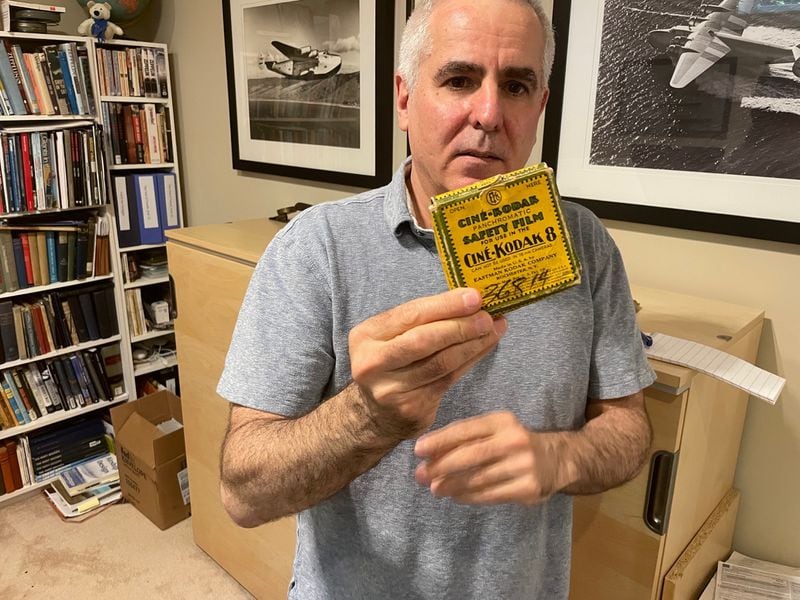The Hindenburg remains a defining disaster for the reason that the conflagration of a Nazi zeppelin in front of many cameras, accompanied by a traditionally psychological soundtrack — “Oh, the humanity!” — just in no way loses its morbid attraction. It speaks to hubris and mankind’s tenuous struggle to subvert mother nature with technologies.
Grossman, a pilot who’d favor to be flying or exploring a reserve than preventing Metropolis Corridor, is an qualified on all styles of traveling from the 1920s until finally the 1960s, and has aided all styles of films, textbooks and documentaries. He goes back and forth on how prudent it was to fly a behemoth that was a few moments the duration of a 747, was loaded with 16 million cubic ft of hydrogen, and necessary 300 guys pulling ropes to get it to the floor.

Dan Grossman, an Atlanta attorney and an specialist on airships from prolonged back, holds a piece of the Hindenburg’s steel frame in his home. He can take part in a PBS “NOVA” documentary on the disaster. (Image by Bill Torpy)
Credit history: Invoice Torpy
Credit rating: Invoice Torpy
Supported by an interior framework, zeppelins ended up “an engineering miracle,” mentioned Grossman. They were light for their size, strong and simple, equipped to have 100 folks, together with the crew. And they were being rapidly — two-as well as days to cross the Atlantic compared to five days in an ocean liner.
“It was the Concorde of its time,” mentioned Grossman. People today compensated $450, about $8,300 in today’s funds, to travel aboard the behemoth.
Even so, Grossman asked, “Why was a traveling bomb a fantastic idea? It’s sort of a dumb strategy, an illustration of, ‘If a thing works on a compact scale, let’s make it major.’ It is a technological innovation that is inherently challenging. It’s like a huge sail. It is a wall in the air (that catches wind and can be blown about). Airships were a technologically dumb plan. But there just wasn’t anything else at the time.”
So why does one come to be a globe-renowned qualified on zeppelins?
“First of all, they are sort of amazing,” he explained. “They’re gigantic points that can float.”
Sure, that’s a offered. Make sure you go on.
“Airships for a period of historical past represented a delightfully naïve enthusiasm about engineering and the long term,” he stated. Plus, Grossman was captivated for the reason that the engineering is comprehensible.
“Give me a 1950s Ford truck and I can adjust the spark plugs,” Grossman reported. “A contemporary 1 is computerized. I would not know in which to get started. The technologies of that time is obtainable. There is nothing about an airplane of the 1930s I do not fully grasp.”
Grossman acquired the traveling bug in school and has obsessed with the history of dirigibles for decades. It is a lane not occupied by many some others, he said as we sat in the man cave of his Morningside household, a home with 4 leather chairs, probably 40 framed historical photographs of airships, some china from the Hindenburg (from the non-disastrous flights) and a triangular-formed chunk of the aluminum girder from LZ-129′s ultimate flight.
I mentioned to him that his partitions have no photos of the stricken Hindenburg.

This May 6, 1937, file picture, offered by the Philadelphia Community Ledger, was taken when the Hindenburg exploded around the Lakehurst Naval Air Station in Lakehurst, New Jersey.
“No, no, no, this is about the glory times,” he said laughing, yet severe. ”It’s about the fantastic stuff, only the pleased things.”
“There is so considerably much more to the history of airships with out going into the Hindenburg,” Grossman said. “It’s a very little irritating that all people today want to chat about airships is the Hindenburg.”
“There are so several airship tales I would appreciate to tell,” he stated, pausing to include, “But no a person would pay out for it.”
Perfectly, then, let us speak about the Hindenburg.
A linchpin of the “NOVA” episode centers around some not often witnessed 8 mm movie shot in Lakehurst, New Jersey, on Could 6, 1937, by Harold Schenck, who borrowed the camera from his brother.
In 2012, when Grossman was attending the commemoration of the disaster’s 75th anniversary, he was approached by Bob Schenck, the cameraman’s nephew. “I have some film of the Hindenburg disaster,” Schenck informed him. “This most likely looks the exact same as all the others but if you want to see it, I’ll demonstrate you.”
Grossman understood he had a little something specific when he recognized Harold Schenck was shooting from a distinct angle than the news crews, whose look at was that of the airship traveling toward them. Schenck’s movie was a side check out, exhibiting the complete craft, with nose and tail seen at the identical time, supplying a better impression of the flames’ development. Grossman now owns the film, getting ordered it from the relatives.

Dan Grossman, an Atlanta legal professional and pro on zeppelins and other airships, holds a film that was shot of the Hindenburg disaster that is part of a PBS “NOVA” documentary. (Photo by Monthly bill Torpy)
Credit rating: Monthly bill Torpy
Credit: Invoice Torpy
A surprising actuality of the catastrophe, supplied the ferocity and pace of the destruction, was that just 35 of the 97 people today aboard have been killed, as was a particular person on the floor.
“It was miraculous,” reported Grossman. “It was a concern of when to leap. If you bounce (when it was) as well high, then you don’t endure. If you wait around as well prolonged, it’ll come down on leading of you.”
The documentary mirrored some of the investigations and tests executed in 1937 immediately after the explosion transpired, but this time with a few new twists. There was a leak in the rear of the Hindenburg, earning it “tail heavy” and making it possible for hydrogen gasoline to mix with oxygen. The ropes reduced from the airship received wet in the thunderstorm and, 4 minutes immediately after remaining dropped, turned a conduit for the billed particles buzzing about the frame of the ship.
It was like the spark you get after strolling on a carpet and touching a doorknob. But fortunately, your bedroom doesn’t incorporate 16 million cubic toes of hydrogen.
Grossman claimed the Germans, who were being masters at engineering and precision, were being pressured to use the far more risky hydrogen in their zeppelins somewhat than helium because, a long time before, The usa experienced embargoed its helium stockpile.
The Hindenburg arrived in New Jersey about 12 hours late simply because of headwinds. The airship’s administration and crew felt pressured to shift swiftly simply because they wanted to flip close to and get the return flight prepared to verify they could meet up with a timetable.
“The Germans realized you do not land in a thunderstorm, but they did,” Grossman advised me. “The German manuals created in 1919 stated that. I could clearly show you.”
Many thanks, but I’ll just hold the neat piece of the Hindenburg girder as you demonstrate.
“Why this disaster happened was they stopped being German they rushed it,” Grossman mentioned. “But in that political routine, who do you worry a lot more? The weather or the Gestapo?”
About the Creator


